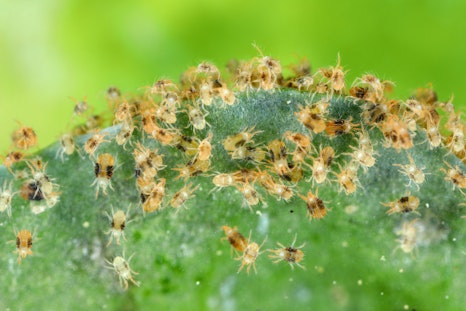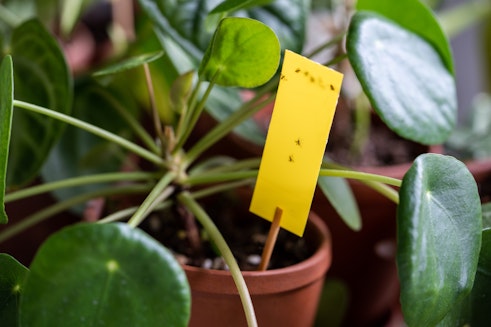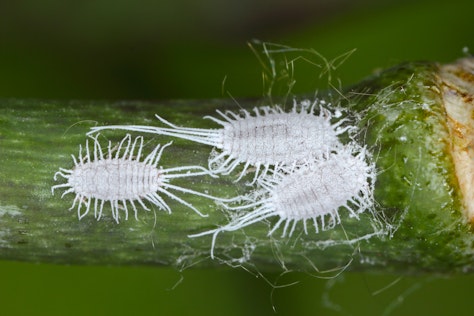
- Home
- How to Get Rid of Bugs on Indoor Plants
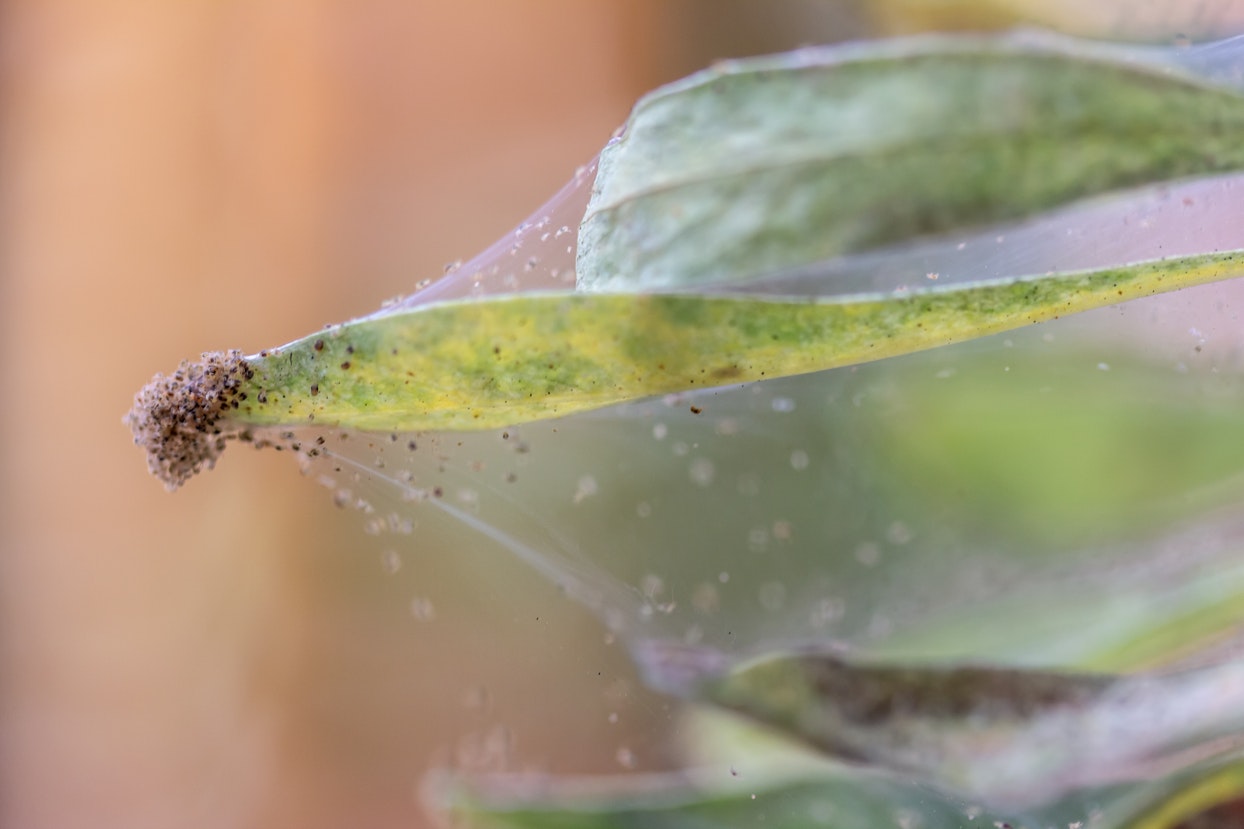
Pests - every glasshouse, botanical garden, native environment will have pests; it’s just part of the ecosystem and having a plant collection. You can handle them!
We all love our plants but we’re not so keen on the uninvited guests they can attract and the damage they can do; with some better understanding we can manage an outbreak and even prevent them.
You might notice some yellowing leaves, or maybe a dusty appearance on the leaf lamina (the flat surface of the leaf), deformed leaves or a sticky substance on the leaves - this is honeydew. Learn more about plant pests and how to get rid of them in this blog.
Where Do Houseplant Pests Come From?
Some come through the window - thrips can fly (wahhh). Some are light enough to move on the wind - spider mites, we’re looking at you. They can enter your homes on your clothing, your pets, cut flowers and undetected on plants.
We check our plants diligently and regularly but sometimes the little sneakies get past us - eggs can be in soil and larvae can be invisible to the naked eye. I have a little hand lens and even a portable microscope to take an extra close look.
How Can I Prevent My Plants from Contracting Pests?
The best preventative is regularly inspecting your plants and keeping them healthy; healthy plants are stronger and less susceptible to pests.
If you keep your plants outside during the warmer months, make sure to thoroughly inspect them before you bring them back inside. Slide your plants out of their plastic nursery pots in case anything has crawled in through the drainage holes; cool, damp soil is a favourite of centipedes.
Isolating new plants for up to 6 weeks before you introduce them to the rest of your collection is also a good recommendation.
When you repot a plant, make sure you’re using a potting mix that has been stored in a sealed bag or container - and if you’re reusing a pot, clean it out with warm soapy water.
Showering your plants regularly or wiping their leaves down is another way of ensuring any pests are washed away and that any dust is removed from the leaves; dusty leaves provide a well-disguised home to some pests.
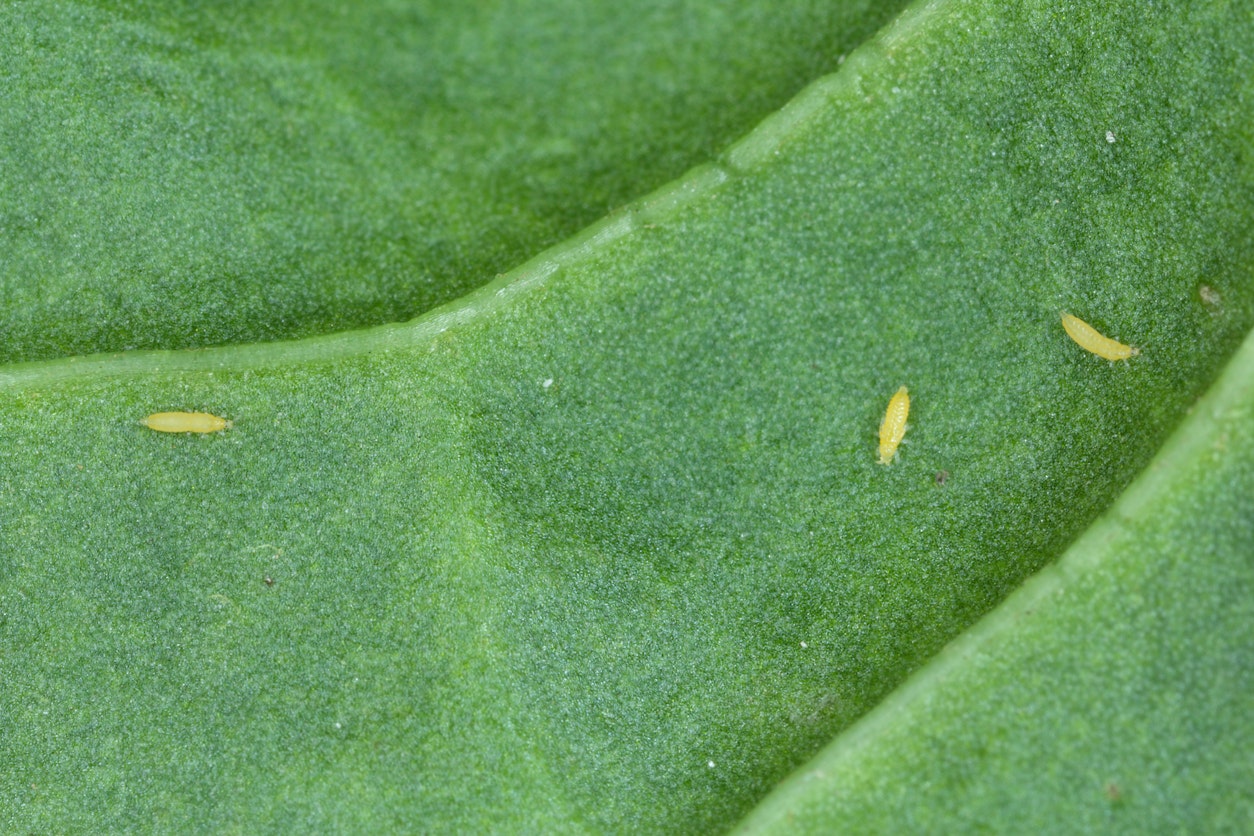
How Do I Check My Plant? What Am I Looking For?
Pests can drop down so start at the top leaf, examine the upper leaf surface but look more thoroughly at the leaf undersides. Look closely at the midribs for webbing, along with the leaf sinus and where the leaf meets the petiole. New growth is the most delicious treat for pests like aphids and mealies so pay close attention to the fresh leaves.
Keep your eyes peeled for fine webs, sticky droplets on the leaves, white fluff that looks like cotton wool, black dots (pest poop). Sudden yellowing of leaves is a good indicator that you might have unwanted guests too.
General Pest Solutions
Spray: For light infestations, some insects can be removed by force, with a spray of water from a pressurised bottle. This can physically remove them from the plant without the use of any chemicals or materials.
Wipe: Similarly, wiping the stems, petioles and leaves of the infested plant with a wet cloth can physically remove them, and eliminate any possible tissue damage from the impact of a spray bottle.
Prune: Sometimes, the infestation can be present only on one section of a plant, if possible, the removal of this section can eliminate the infestation entirely. Otherwise, the removal of any affected leaves can also stop the infestation. This is a good method for stronger plants that may only be affected on their soft, new growth.
Dispose: For severe infestations that cannot be controlled, disposing of the affected plant can be the only solution. This ensures that the infestation cannot spread to other, nearby plants.
Alcohol: A combination of 70% rubbing alcohol and water, applied to the body directly, dissolves the exoskeleton and ensures that the pest succumbs to the elements and dies. This is true also for their eggs and should be reapplied every few days until the infestation is gone.
Insecticidal soap: Mixing a concentration of Insecticidal soap and water, and applying it to all parts of the plant with a spray bottle is a good method to ensure that the whole plant is treated. SB Invigorator is effective but requires 2 applications within 7 days. One to remove
Repotting: For root infestations, changing the soil and washing the roots with insecticidal soap can be a good solution to ensure that pests are not hiding in the soil.
Horticultural oil: Applying neem oil can coat pests and their eggs and suffocate them. The oil can be mixed with water and sprayed directly onto the plant, or poured into the soil for root infestations. These processes should be repeated every few days until the infestation goes away.
Natural predators: Introducing natural predators can be an effective and long-lasting way to control mealybug infestations. Predators can be found easily online and are best for greenhouse or outdoor environments.
Common Pests
Here are some common pests you may find on your plants, along with the damage they cause and how you can eliminate them.
Mealybugs (Pseudococcus Longispinus, Long-tailed Mealybug)
Mealybugs are unarmored scale and are part of the Pseudococcidae family, they’re slow moving and often found hiding in leaf axils and tucked under tendrils wrapped around plant trellis. They typically love to munch on the soft and juicy new growth. Mealybugs also enjoy the sweet, weaker tissue of flowers so always check your blooms too.
The adult females cover themselves and their eggs with a white, waxy material - giving them a cotton wool appearance. Reproduction can be sexual or asexual, with females laying up to 300 eggs before dying. The eggs hatch the nymphs or crawlers after 7-10 days, the first instar nymphs develop their fluffy coat as they start eating; the coat is there to protect them from pesticides. Males are harder to spot and don’t occur as often as they aren’t present in all species, they are small gnat-like insects (about 2 mm long), with two pairs of wings. Mealybugs thrive in warm (25˚C) and higher humidity conditions.
What Damage Do Mealybugs Cause?
Nymphs and female mealies extract the sap from the plant, using their piercing-sucking mouthparts. This can stunt growth, lead to deformed/yellow leaves and in some cases leaf loss. Damage from mealybugs reduces photosynthesis and can even lead to plant death if the infestation is severe. Mealybugs have to ingest large quantities of sap in order to survive; sap is low in protein but high in sugars. Excess sugars are excreted in the form of honeydew. It’s possible you might observe some dark sooty mould growing on the honeydew too.
How Do I Treat Mealybugs?
To get rid of mealybugs, isolate the plant from the rest of your collection to prevent the pests from spreading. You can remove the mealybugs and their egg sacs manually with a small paintbrush and a diluted solution of water and isopropyl alcohol (70:30). I would then hose the plant down in the shower or outside with a hose, concentrating on the leaf axils and undersides of leaves. You can tie a plastic bag around the pot to prevent soil loss.
The next step is to spray the plant with SB Invigorator, the first application will remove the waxy coat from any remaining mealybugs, the second application will kill them; spray twice within 7 days.
Alternatively, you could use neem oil, dilute it per the instructions on the bottle and spray all over the plant. I would suggest mixing it with some washing-up liquid and a few drops of lavender oil to reduce the scent of the neem.
Biological control is another great option for treatment, mealybugs have a number of natural enemies! Cryptolaemus montrouzieri ladybird is often called the ‘mealybug destroyer’ as both larvae and adults feed on mealybug. Green lacewing (Mallada signata) larvae are prolific predators of mealybug as well as of a number of other plant pests. You can purchase natural predators online. If pesticides have been applied, ensure that a sufficient time period has elapsed before releasing predators.
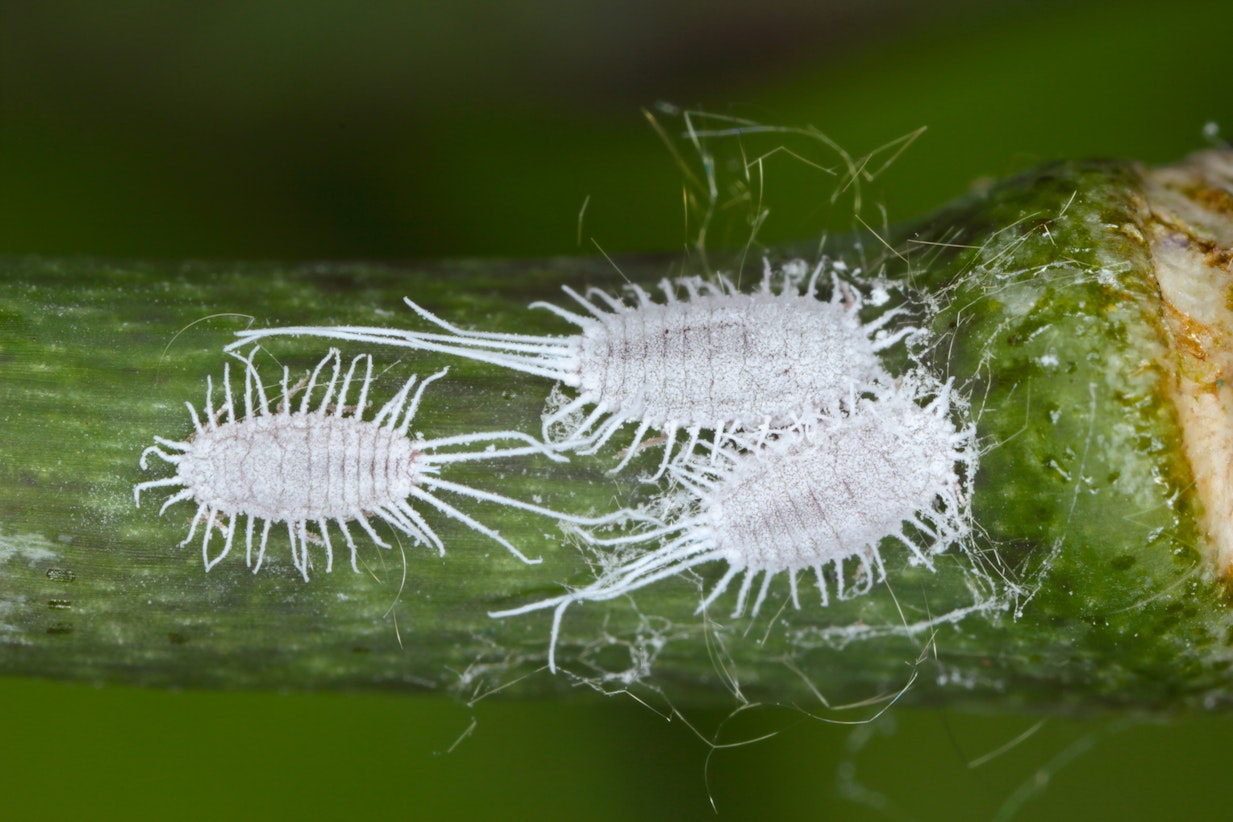
Thrips (Echinothrips americanus)
Thrips are tiny, slender insects with fringed wings, they are often light to dark brown and occasionally black. There are more than 6,000 known species; most are harmless, some are predators, and fewer than 20 species can cause problems in agriculture and horticulture. They are typically found on leaves - both adaxial and abaxial (upper and undersides) feeding on the softer new growth with their tiny needle-like mouthparts by piercing the cell and sucking out the contents which leads the surrounding tissue to die.
Female thrips lay their eggs inside plant tissue, this is anything between 80-300 eggs, depending upon the species, host plant and environmental conditions. They have two larval stages that actively feed (Instars) , followed by two or three non-feeding pupal stages. Larvae are light to yellowish green in colour, with a large head. Thrips lay their eggs inside plant tissue or in the soil and as the larvae are so small, the damage they do is often missed.
What Damage Do Thrips Cause?
When thrips feed on older growth, they suck up cell contents and in time this leads to a reduction in photosynthesis. If the thrips are feeding on new growth, leaf formation can be disrupted and leaves can become distorted, scarred and occasionally drop off.
Look for silvery patches on the leaves (damage) and for teeny black blobs on the leaves, this is their frass (poop). Thrip damage may also present similarly to that of spider mites; spotted or streaked leaves and some leaf wilt. They are particularly keen on Monstera and Alocasia.
How Do I Treat Thrips?
Isolate the plant from your other plants to prevent the thrips from spreading. Thrips can be physically removed by hand with masking tape or a lint roller on strong enough foliage. I find hosing foliage down on both leaf upper and undersides helpful too, then using an insecticidal soap. Hanging blue sticky traps above or amongst the plants is a useful way to catch the thrips.
You could also use neem oil, dilute it per the instructions on the bottle and spray all over the plant. I would suggest mixing with some washing up liquid and a few drops of lavender oil to reduce the scent of the neem. Repeat treatments may be required depending on the severity of the thrip infestation.
There are also some curative biological control options; Amblyseius swirskii or Amblyseius cucumeris are excellent predatory mites, if you see large numbers of adult thrips, Orius laevigatus is the predator you need to introduce. For possible thrip larvae in the soil apply Macrocheles robustulus, these are predatory mites that live in the soil and feed thrip pupae and sciarid fly larvae.
If pesticides have been applied, ensure that a sufficient time period has elapsed before releasing predators.

Aphids (Aphididae)
Aphids are small, bulbous, soft-bodied insects which include greenfly and blackfly. They are mostly female and can reproduce asexually and therefore able to produce young rapidly and in high numbers; under optimum conditions a female aphid can produce up to 10 eggs per day over a few days.
The first instar nymphs are born and begin feeding almost immediately, they will each moult through a number of immature stages and eventually become an adult (female) that can then begin reproducing. Certain species produce male aphids just before the cooler temperatures of winter hit, they mate then the females lay eggs that will overwinter and then hatch in spring.
It is only the adults you will observe with wings, the instars are the small, almond-shaped wingless green bugs which leave behind their white exoskeletons on the leaves.
What Damage Do Aphids Cause?
Aphid damage is typically most visible on tender new leaf growth, this is where you might see dense groups of them busily sucking up plant juices. The mouthparts of the aphid are perfectly designed to pierce plant tissue and extract the sugar-rich sap from the phloem. They then deposit the digested cell content as honeydew; the sugary blobs on leaves and stems.
The honeydew can also grow sooty mould which further destroys the appearance of our plants. Young leaves that are fed upon by the aphids may appear deformed or stunted when they expand and unfurl. If the aphids have been feeding on older leaves the leaf may become chlorotic (yellowing), wilt and fall from the plant.
How Do I Treat Aphids?
Isolate the plant from the rest of your collection and prune off any badly infested stems or leaves then hose the plant down to physically remove as many aphids as possible. For more delicate plants you could dilute isopropyl alcohol with water (70:30) and with a small paintbrush, manually remove the aphids.
Garlic water is thought to be a good homemade remedy; boil garlic cloves and allow the mixture to sit for 20 mins, then add to a spray bottle and spray all over your plant. This works by killing the aphids on contact and the smell will deter them from sticking around. I’ve not tried this myself but I have seen it mentioned a lot online.
You could use neem oil, dilute it per the instructions on the bottle and spray all over the plant. I would suggest mixing with some washing-up liquid and a few drops of lavender oil to reduce the scent of the neem. Horticultural soap is another option, you could buy a ready-to-use one or make your own. It’s important to be consistent when applying any spray-on treatments. I have also had success with SB Invigorator as a treatment for aphids.
Biological control could be used; Aphidius colemani and Aphidius ervi are very small parasitic wasps which lay their egg inside the aphids, the aphid then dies and the Aphidius emerges to seek out more aphids and so the cycle continues. Lacewing larvae are also a good option as they are a highly effective predator of aphids; one lacewing larvae consumes up to 200 aphids.
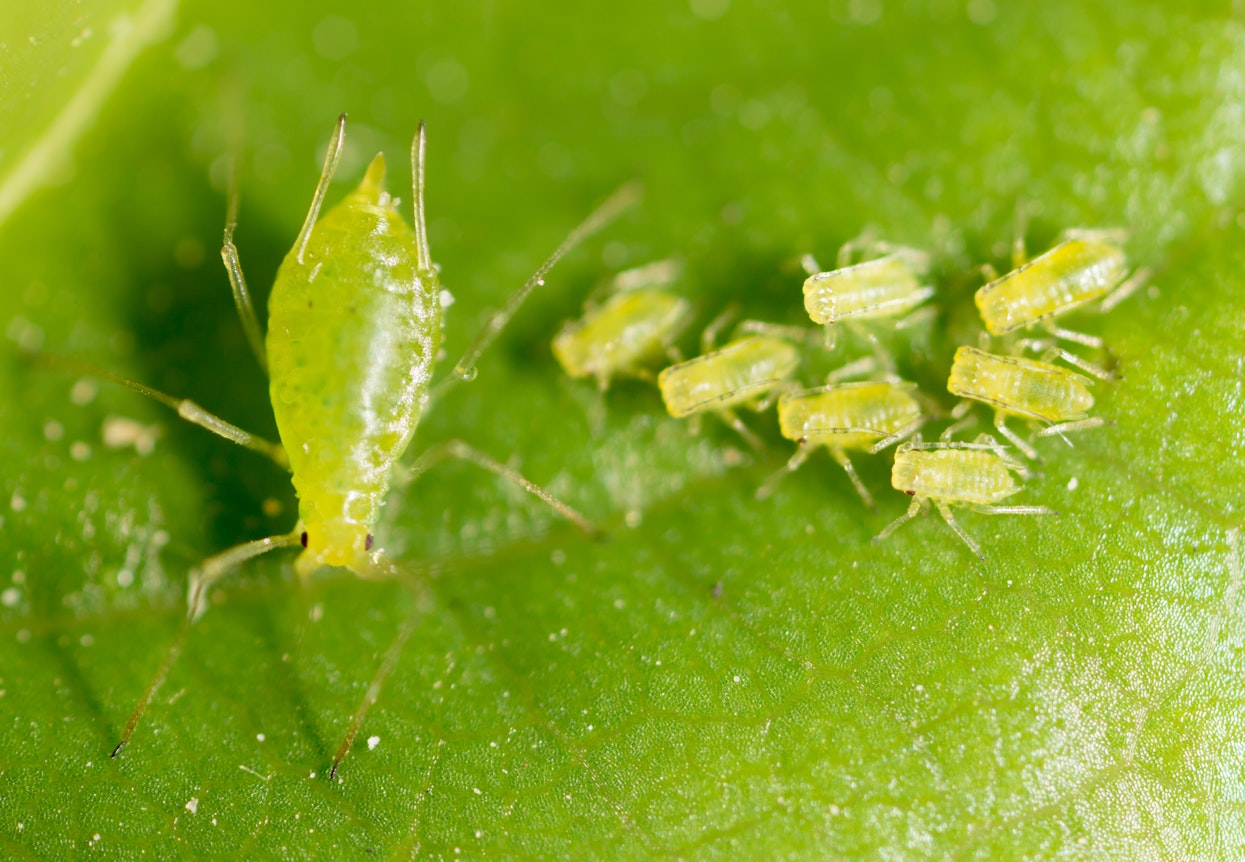
Spider Mites (Tetranychus urtica)
One of the most commonly found spider mites is the two spotted spider mite, they are about 0.5mm long with oval bodies and eight legs, colours vary from yellow, orange and brown. They’re very slow moving and are usually found on the leaf abaxial (leaf undersides) where they produce very fine webs between the midvein and the leaf margins.
Spider mites have four stages to their life cycle; egg, larva, nymph, and adult. Under optimum conditions (high temperatures and low humidity), they can complete the cycle in 5 to 7 days. I have found them to be most common on Calathea and Philodendron.
What Damage Do Spider Mites Cause?
They feed in a different way to other sap-suckers as they feed on cells within the leaf mesophyll rather than the phloem. This feeding manner causes the formation of chlorotic spots that are associated with an extensive collapse of the mesophyll layer. Leaves turn yellow or bronze in some cases.
How Do I Treat Spider Mites?
When you first suspect spider mites, separate the plant from the rest of your collection and hose down the plant. Wrap a plastic bag around the soil and then shower or hose down the plant, focussing on the leaf undersides and leaf axils. Then spray the entire plant with either SB Invigorator, a neem oil solution or a horticultural soap.
If you want to treat the infestation with predators then a combination of Amblyseius californicus and Phytoseiulus persimilis is a great option. If pesticides have been applied, ensure that a sufficient time period has elapsed before releasing predators.

Fungus Gnats (Sciarid fly)
Fungus gnats are more of a nuisance than a true pest, they thrive in damp soils and humid conditions and are disturbed when we pick our plants up or water them. Adult fungus gnats lay around 300 eggs at one time, these then hatch and have four larval instars, a pupal instar, and then develop into an adult.
The larvae mainly feed on decaying plant matter and fungi present in the soil, in some cases they feed on root hairs and rootlets. Adult flies are between 1-5 mm long with black bodies, clear venation on their wings and long antennae.
What Damage Do Fungus Gnats Cause?
Fungus gnats cause minimal damage to our plants, they’re more of a nuisance to us as they fly around our faces when we exhale seeking out our sweat and tears!
How Do I Treat Fungus Gnats?
Populations can boom so the first thing I would suggest is allowing the potting mix to dry out without causing stress to the plant. Next add some sticky fly traps to the pots, close the soil to catch the adult fungus gnats.
If the potting mix is taking too long to dry out, it could be that the mix is too dense and is therefore the ideal spot for fungus gnat larvae, in this case, I’d suggest changing the potting mix. Make sure you keep your potting mix supplies in a sealed container or packet to keep it biosecure.
An effective method for controlling fungus gnats is the application of Steinernema feltiae nematodes; they work by entering the larvae and feeding on them, the nematodes produce a bacterium which kills the larvae and prevents further infestation. Learn more about getting rid of flies from your indoor plants here.
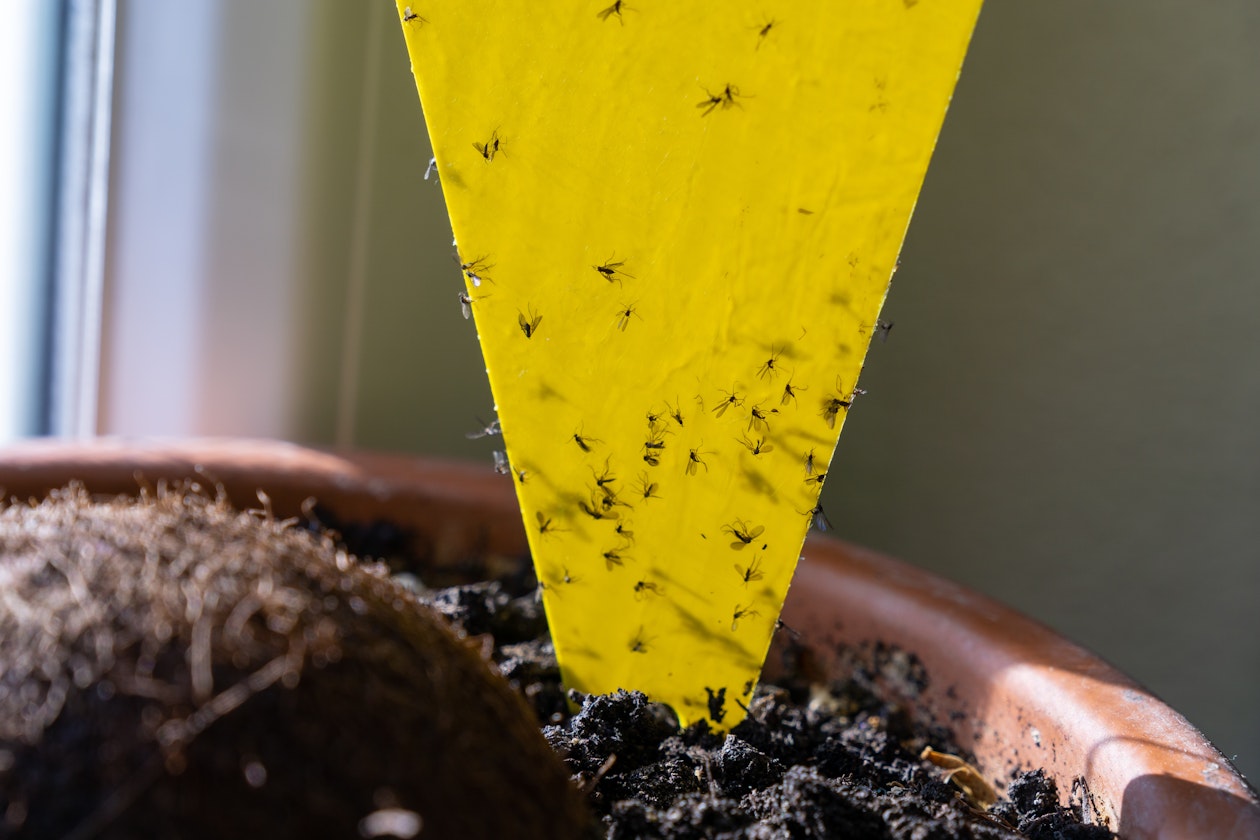
Scale Insects (Coccoidea)
Scale are a weird-looking insect, of which the females do not evolve legs or bodies but instead remain immobile and form a hard, waxy shell over themselves for protection. The males are aphid-like, flying insects that do not eat, but fly around reproducing with the immobile females. The females can also reproduce asexually, meaning a small infestation can grow quickly.
What Damage Do Scale Insects Cause?
Scale seal themselves onto the surface of leaves and feed off the sap and nutrients inside the leaf tissue. These insects are hard to remove and can withstand most pesticides, as the chemicals just run off the shell and do not affect the creature living inside.
How Do I Treat Scale?
The best way to effectively treat scale is by forced removal, as the protective shell they produce is a useful defence mechanism for them when facing liquid-based solutions. They can be removed one by one with tweezers or by scraping, or a high-pressure water spray too. Unfortunately, scale infestations are often very large and this type of approach would take hours, if not days!
Alternatively, a pesticide that dissolves the shell should be able to remove them effectively. Neem oil dissolves the hard tissue of the insect’s exoskeleton, causing their soft bodies to be exposed to the elements, killing the insect. Further, SB invigorator is a home-friendly chemical solution that succeeds in this also.
Bibliography
- https://extension.okstate.edu/programs/digital-diagnostics/insects-and-arthropods
- https://www.koppert.co.uk/challenges/pest-control/mealybugs-and-scales
- www.bulletinofinsectology.org/pdfarticles/vol71-2018-001-009alliaume.pdf
- www.horticulture.com.au/globalassets/hort-innovation/resource-assets/ny11001-mealy-bugs.pdf
- https://www.sciencedirect.com/science/article/abs/pii/B9780123275509500082
- Aphid-plant interactions: a review - Journal of Plant InteractionsVol. 3, No. 4, December 2008, 223232 - -https://www.researchgate.net/publication/277495565_Aphid-plant_interactions_A_review#pf3
- Front Plant Sci. 2016; 7:1105
Jonathan Davies
Jonny has worked at Root since May 2023. His love for plants was inherited initially from his grandparents and parents, but really took off once he moved into his own place, where he started picking up small plants and was fascinated by watching how they grow and change over time. Jonny has a degree in Archaeology and Classics from the University of Sheffield, and a masters in Egyptology from Swansea University, where he primarily focused on garden culture in the ancient world, which he has managed to extend to a PhD thesis in the University of Liverpool, where he has been able to combine his love for plants with his love for ancient language and culture. Jonny loves being in the natural spaces around North Wales and Cheshire where he used to go growing up, and often spends hours examining the plants and trees, and kicking up the leaf litter searching for mushrooms and insects. He is fascinated most by plant biology, taxonomy and learning about ecosystems and interactions between plants and their environmental counterparts, and enjoys tending to his varied array of houseplants, and ongoing ‘plant projects’, such as growing plants from seeds and creating living epiphyte displays. Aside from his green thumb, his other interests include: art, reading, listening to and playing music in the company of his cats, Spooky and Boo.
More by Jonathan DaviesRelated Articles
View all articles
